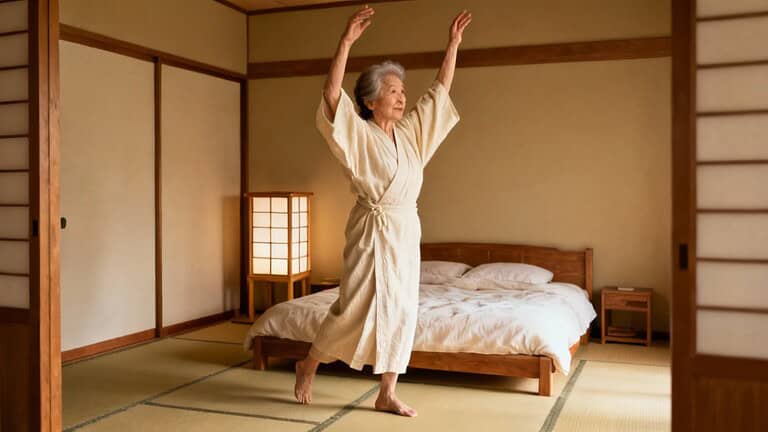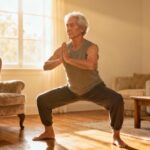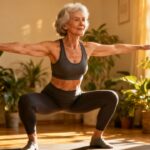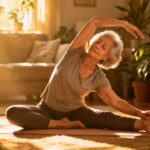Picture this: a quiet park in Tokyo at dawn. An 80-year-old woman bends down, touches her toes, and stands back up without a sound. No groaning, no wobbling, no ‘oh my knees’—just smooth, graceful movement.
Now imagine the same morning in Los Angeles, where people half her age reach for pain cream before they reach for coffee. What’s happening here?
The Japanese have a secret, and it’s not in their diet or supplements. It’s in how they move, especially before bed.
For generations, Japanese elders have practiced a short nightly ritual of gentle movements that tell the body, ‘You’re safe. You can relax. You can repair.’ Modern science is finally catching up to what they’ve known all along.
The Science Behind Japanese Bedtime Movements
Recent studies from Japan’s top gerontology institutes show that these slow, mindful movements before sleep can increase joint fluid production and reduce inflammation overnight. In other words, your body can quietly rebuild itself while you rest.
These five simple bedtime movements take less than 15 minutes, require no equipment, and may just change the way you wake up tomorrow.
Movement 1: The Quiet Release Seated Forward Fold
In Japan, elders call this movement their nightly reset. It looks simple: sitting on the floor, legs stretched out, slowly folding forward. But what’s happening inside the body is extraordinary.
As we age, our bodies start to guard against movement. The brain interprets tightness as danger. Every ache, every stiffness is your body whispering, ‘Don’t move. You might get hurt.’ The forward fold gently teaches the body to trust again.
Researchers at Kyoto Medical Center observed something fascinating when older adults practiced this position nightly. Within three minutes of holding the pose, muscle tension in the lower back decreased by 42%. Participants didn’t just gain flexibility; they reported feeling light, unlocked, and calmer before sleep.
How to Do It
- Sit on the floor or the edge of your bed.
- Extend both legs straight.
- Sit tall as if a string is lifting the top of your head.
- Slowly walk your hands forward along your legs until you feel a gentle stretch in your hamstrings or lower back.
- Hold for two to three minutes. Breathe deeply through your belly. Each exhale lets your body melt a little further.
Safety Notes
Avoid this movement if you have severe spinal disc issues, recent back surgery, or uncontrolled high blood pressure. If sitting on the floor causes discomfort, perform it from a chair by resting your chest on your thighs instead.
Movement 2: The Gentle Reset Lying Spinal Twist
At first glance, this movement looks like rest. You’re lying on your back, arms spread wide, eyes closed, knees drifting to one side. But inside your body, something remarkable is unfolding.
Japanese elders call it the gentle reset, a nightly ritual that unwinds not only the spine but also the tension life quietly stores in your joints.
Researchers at the Tokyo Institute of Gerontology found that seniors who practice gentle spinal twists before bed experienced measurable changes in just eight weeks.
Their spine regained flexibility. Their morning stiffness dropped by more than half. And most surprising of all, their sleep quality improved dramatically.
How to Do It
- Lie on your back, knees bent, feet flat on the floor.
- Let your knees fall gently to one side while keeping both shoulders grounded.
- Spread your arms into a T-shape.
- Turn your head in the opposite direction of your knees.
- Hold for at least 90 seconds. Then switch sides.
- Breathe deeply into your rib cage, imagining your breath expanding the stretched side.
Movement 3: The Breath of Motion Cat Cow Flow
This movement may look familiar, but the way Japanese elders approach it gives it new life. They call it the breath of motion, a fluid rhythmic practice that reconnects your spine with your breath.
Most people think stiffness comes from age. But researchers at Osaka University discovered something surprising: it comes from stagnation. When the fluid surrounding your brain and spine, called cerebral spinal fluid, stops circulating freely.
The cat cow movement acts as a natural pump, increasing that circulation by up to 38% in older adults. The result: clearer thinking, easier movement, mornings that don’t begin with stiffness or fog.
How to Do It
- Start on your hands and knees.
- Align your wrists under your shoulders, knees under your hips.
- Inhale as you drop your belly toward the floor.
- Lift your chest and tailbone. This is cow.
- Exhale as you round your spine toward the ceiling.
- Tuck your chin and pelvis. This is cat.
- Flow slowly between them for two minutes, matching each movement to your breath.
Movement 4: The Forgotten Joints Ankle and Hip Circles
Ask any Japanese elder about aging gracefully, and they’ll tell you it begins with your feet. In their culture, balance isn’t just physical—it’s a philosophy. Yet in the West, ankles and hips are often the most neglected joints.
Researchers at Nagoya University followed nearly 900 seniors for three years. Those who practiced nightly ankle and hip rotations didn’t just move better; they lived better. Their risk of falls dropped by 73%. Their walking speed increased by 23%. And knee pain eased significantly.
How to Do It
- Sit comfortably on your bed or a chair.
- Extend one leg and slowly rotate your ankle 10 times clockwise, then 10 times counterclockwise.
- Switch legs. Next, lie on your back.
- Bend one knee and gently draw small circles in the air with that knee, five each direction.
- Feel the hip joint move smoothly. Repeat with the other leg.
Movement 5: The Gravity Reversal Legs Up the Wall
At first, it seems too simple to matter. You lie on your back, place your legs up against a wall, and breathe. That’s it. Yet, this ancient Japanese ritual practiced quietly before sleep is one of the most powerful tools for joint renewal and deep rest.
Tokyo Metropolitan Institute of Gerontology found that elders who practiced this nightly for just five minutes reported 64% less joint pain and significantly deeper sleep within weeks.
This gentle inversion also decompresses the spine, allowing the discs between your vertebrae to rehydrate overnight. Imagine it as your body quietly refilling its cushions while you rest.
How to Do It
- Lie on your back near a wall, hips about six inches away.
- Extend your legs upward, resting them gently on the wall.
- Keep a soft bend in your knees.
- Rest your arms by your sides, palms up.
- Close your eyes and breathe slowly for three to five minutes.
Putting It All Together: Your Nightly Ritual
Imagine waking up tomorrow and realizing your first movement of the day doesn’t hurt. No stiffness, no groaning, no hesitation—just ease. That’s not wishful thinking. It’s the reward your body gives when you care for it with intention.
These five bedtime movements aren’t about chasing youth. They’re about reclaiming your right to feel free in your own body. The Japanese have shown us something powerful: aging gracefully isn’t about avoiding time. It’s about working with it.
Every night becomes an opportunity to reset, to drain inflammation, restore balance, and tell your body you’re safe to heal now. It’s remarkable how much can change when you give yourself just 12 quiet minutes before sleep.
And here’s the truth most people overlook: flexibility is not a gift of youth. It’s a skill of consistency. Your joints respond to attention like flowers respond to water. You don’t need perfection. You just need presence.
Try this for one week. Notice how your mornings begin to shift, how you move with more confidence, how you sleep more deeply, how your body starts to trust itself again. These movements aren’t just stretches. They’re small acts of self-respect.
They remind you that aging isn’t decline—it’s adaptation. The body never forgets how to heal. It just waits for the signal. Tonight, you’re sending that signal.








